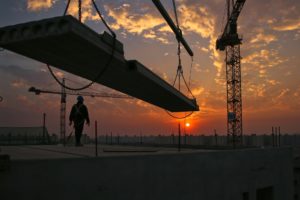Subway construction is a complex and arduous task that is the lifeblood of modern cities. Over time, technological advances and innovative construction methods have revolutionized subway construction. New technologies have not only increased efficiency and speed, but also environmental sustainability and safety. In this article, we take a look at the latest construction techniques that have transformed subway construction in recent years, and look to the future to see what’s to come.
Tunnel boring machines: Civil engineering marvels
One of the most important innovations in modern subway construction is the tunnel boring machine (TBM). These gigantic machines work like giant moles, digging holes in the ground with amazing speed and precision to build tunnels. TBMs are equipped with cutting wheels and cutting tools that loosen the soil while supporting the tunnel tube. There are many advantages to driving a TBM, including significantly less surface disturbance, increased worker safety and faster tunnel completion. TBMs are capable of working in difficult ground conditions and digging tunnels with different diameters depending on the requirements of the metro network.
Microtunnelling: small but mighty
Microtunneling is another breakthrough technology that has revolutionized subway construction. This method is often used to build short tunnels under obstacles such as rivers or thoroughfares. Unlike conventional methods, microtunnelling requires minimal surface intervention. The tunnel tube is excavated by a tunnel boring machine controlled from a control center. The microtunnelling machine can handle sharp curves and complex routes, making it possible to build subway tunnels in places that were previously difficult or impossible.
Shotcrete and tunneling in alpine terrain
Building subways in alpine regions presents engineers with special challenges. Steep slopes and treacherous terrain require special construction methods for building tunnels. This is where shotcrete comes into play. In the shotcrete process, a mixture of cement, sand and water is sprayed onto the tunnel walls to form a strong and watertight lining. This allows tunnels to be built at extreme altitudes and under difficult geological conditions.
Prefabrication and key tunnel elements.
Prefabrication of key tunnel elements further accelerates and simplifies the construction of metros. Prefabricated elements such as tunnel rings and tunnel segments are manufactured in factories and then assembled at the construction site. This method shortens on-site construction time and minimizes disruption to traffic and residents. In addition, the use of key components improves the quality and precision of tunnel construction.
Integration of underground construction
In some cities, subway stations and tunnels are integrated directly into existing buildings. This allows efficient use of available space and promotes urban sustainability. Integrating subway stations into building complexes also allows for seamless connections with other modes of transportation and services.
Environmentally friendly construction methods in metro building
Environmentally friendly construction methods are becoming increasingly important in metro construction in view of growing environmental awareness and sustainability. Many cities are turning to renewable energy sources to reduce the energy consumption of subways. Solar panels and energy recovery systems are being used to generate some of the electricity needed. In addition, building materials with lower environmental impact are used to reduce the carbon footprint.
Digital technology and automation
The advancement of digitalization and automation has also influenced subway construction. Digital technology enables accurate planning and modeling of tunnel construction. Virtual simulations can identify potential problems in advance and develop solutions. Automated construction machinery and robotics increase the efficiency and safety of the construction process.
The importance of integration into the urban space
Integration into the urban space is crucial when introducing new construction methods in subway construction. Metro construction should not only improve travel for citizens, but also enhance the quality of life and attractiveness of the city. Well-planned integration of metro stations into the urban environment can improve the environment and enrich urban life.
Challenges and opportunities
Despite all the progress and innovations, the new construction methods in metro construction also face challenges. The cost and financing of metro projects often pose significant challenges. Integrating new technologies and construction methods requires close collaboration among planners, engineers, policy makers, and other stakeholders.
Future outlook
The future of metro construction will be characterized by continued advancements in technologies and construction methods. With growing concerns about sustainability and environmental impact, innovative solutions will be sought to reduce energy consumption and environmental impact. Digital technology and automation will make metro construction more efficient and safer. In addition, integrating metros into urban areas and addressing demographic needs will continue to grow in importance.
Summary
Construction methods in subway building have evolved rapidly in recent years. Innovations ranging from tunnel boring machines and microtunneling to environmentally friendly methods and digital technologies have revolutionized subway construction. New construction methods have made subway construction more efficient, safer and environmentally friendly.



